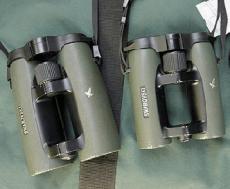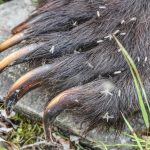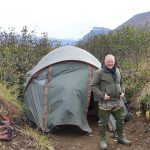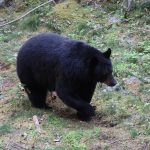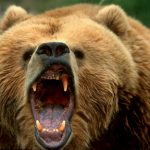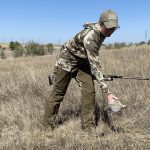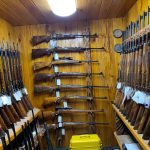The very best binoculars won’t help you unless you know how to use them correctly.
We were very early in an Alaskan bear hunt. The area was good and the weather forecast was favorable. We had time, so we had no reason to be in a hurry. Our guide, Alisha Decker, had glassed a bear from two miles out, a tiny dark speck. Just to see the bear was an amazing feat of glassing, especially from a bobbing boat, but she had home-court advantage: She started hunting the beaches and coves of the Alaska’s “ABC Islands” with her Dad, Jimmie Rosenbruch, when she was seven, so she knows where all the gray rocks and black stumps are. Anything new and dark is likely to be a bear.
So we went in to take a look at the bear, and since this was Donna’s hunt, not mine, I had the luxury of objectivity. We were maybe a mile out before I could actually see the bear, and at about that distance I glanced back at Alisha, who was alternating between steering the boat and looking through her binocular, and I realized she was serious. We weren’t going in to look at this bear. We were going in to shoot him, if we could, because even at that distance, from an unstable platform, she already knew exactly what this bear was. We landed, made an approach, and shot the bear. His hide squared exactly ten feet, a bear you couldn’t pass on the first day, last day, or any day in between. Alisha saw this from an impossible distance.
I cannot give you pointers that will allow such feats of observation. But I can tell you that this is a classic illustration of one of the most important principles in glassing: The idea isn’t just to look; what is important is to see what you’re looking at. How many times have you perfunctorily scanned a hillside, proclaimed it clean, and then kept moving?
Good glass matters, but only if you really use it. I have seen local guides in the Third World–in Africa, Asia, and especially northern Mexico–perform amazing feats of spotting game with absolutely horrible optics. The real enemy of effective glassing isn’t the budget to buy better glass, but laziness and boredom. I freely admit that I have my limits; I can only sit in one spot for so long, and then I get antsy and have to move.
In some cases, that’s OK; for example, spotting white sheep and goats is pretty easy. But with animals that really blend in, like Coues white-tailed deer, there is simply no such thing as too much patience, and no such thing as looking at the same hillside for too long. The guys who are good at it may spend an entire day–and will certainly spend several hours–painstakingly glassing one ridge or valley. I do not pretend to be good at that kind of really serious glassing, but I have learned a lot from it. Coues deer hunting is the most optics-intensive hunting I have done anywhere in the world, so the Coues deer hunt is a great teacher for glassing, and here are some key lessons:
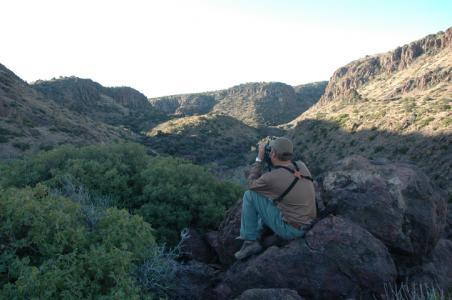
In West Texas, outfitter Hunter Ross takes a careful look for aoudad. This is pretty good glassing technique—nice and comfortable, with the binocular well-rested.
1. You gotta believe. In order to glass effectively you have to believe that what you’re looking for is there, and it’s simply your job to find it. This may be based on scouting, past experience, just the look of the country, whatever, but only if you have confidence that the game you seek is present can you have the patience to keep looking until you see it.
2. Persistence counts. The fact that the game is there doesn’t necessarily mean you can see it. Of course, the animals you’re looking for may not be there on that day, no matter how much faith you have. But they might well be there, but in a location or position where it’s impossible to see them–behind vegetation or in hidden folds in the terrain. So if you really think you’re looking in a very good place, don’t give up. Change angles if possible, and if you have multiple vantage points within reach, change times of day.
3. Movement, color, texture. Human eyes (like those of most predators) key primarily on movement. While it’s true that most animals are more active in the early morning and late afternoon, midday movement is more common than you think. Realistically, no matter how good you are (or how good your glass), most animals will be bedded in positions where they cannot be seen until they move. This also speaks to patience and persistence! However, the human brain does offer other advantages. Unlike most animals, we see colors very well, and we are also able to see textures and the slight differences in reflection between, say, a horn or antler and a branch or rock. When glassing you are always looking for even the slightest clue, and only rarely will it be a complete animal.
4. Get comfy and take a rest! If you are standing up and glassing then you’re really just going through the motions. You aren’t completely steady, and your optics are magnifying your wobbles. You can see animals that are fairly close or relatively obvious, and perhaps you can get a better look at something you’ve noticed with your naked eyes, but you are very unlikely to discover anything new until you rest your optics, no different from shooting a rifle at longer ranges. If there’s a small object or area that you want to see better you can rest against a tree or over the roof of a vehicle, but if you really want to glass, then you need to get comfortable. I like to find a spot where I can sit down and rest my binocular over my knees. That is very comfortable and very effective for me, but even that isn’t the most serious glassing. The guys who are really good at it, like my Coues deer hunting mentors, can pick apart an entire mountain, piece by piece.
Coues deer guides are looking for a very small and indistinct deer in very big country, so they tend to use big optics. For finding game, binoculars are always better than spotting scopes because of the eyestrain from using just one eye, but the Coues deer finders put powerful binoculars–15X, 20X, more–on steady tripods. They’ll get comfortable–often carrying backrests and cushions–and glass for hours. Depending on your country and what you’re looking for, a standard 8X or 10X binocular may be plenty, and under your conditions your knees may work as well as a tripod.
5. Establish a system. Establish a pattern of how you glass, and stick to it. Long-time Coues outfitter Kirk Kelso is as good as anyone I know. He picks a “panel” on a ridge, usually starting at the top and then working down, but that depends on the light. When he feels he has actually seen that panel, not just looked at it, then he moves to the next panel. When he’s done he might move to a different spot, but he might also go right back to the beginning and start over, because the light will have changed and animals might have moved. The important part here is to establish a consistent system so that you not only look at (and try to see) the entire piece of country before you, but you also devote more or less equal time to glassing each nook and cranny.
Unfortunately, in our affluent and technological society we tend to think that we can buy expertise by simply getting better and more sophisticated equipment. This is not true with shooting, and it is not true with glassing. I do believe in good optics, and I genuinely believe that you get what you pay for in optics, but even the very best optics aren’t going to do you any good unless you use them well and properly. Technique is important, but confidence and patience are what really locates game.
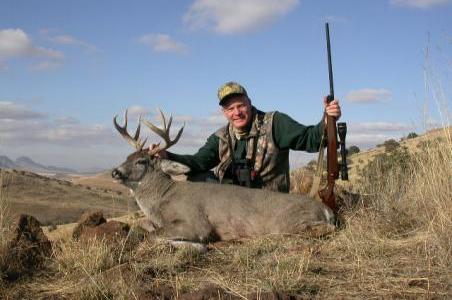
A great Coues buck from Chihuahua. I have no idea how far this buck was when first glassed, but I think more than five miles. It takes a bit of luck to see animals at such distances—but if you look long enough and hard enough luck will come along.

